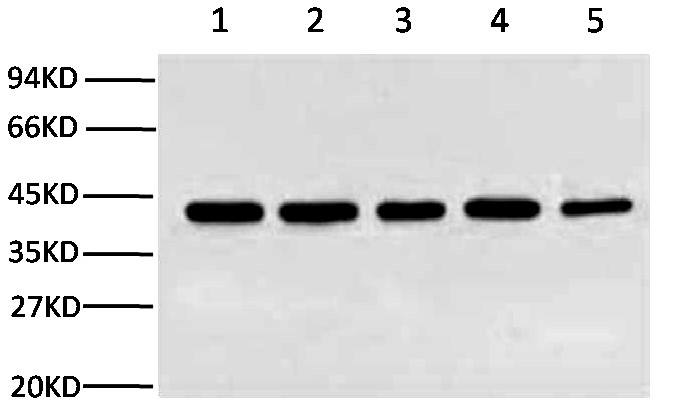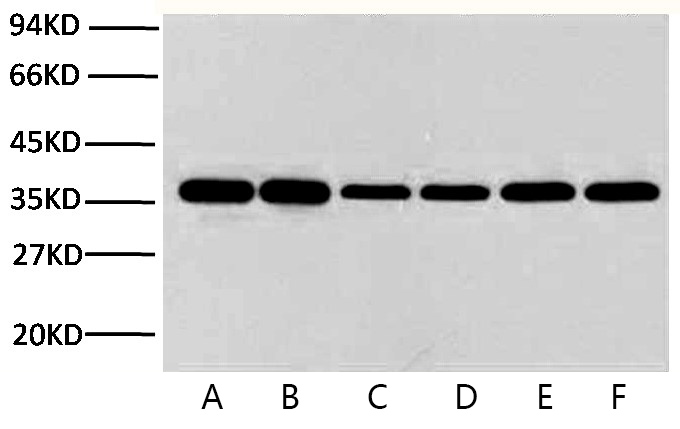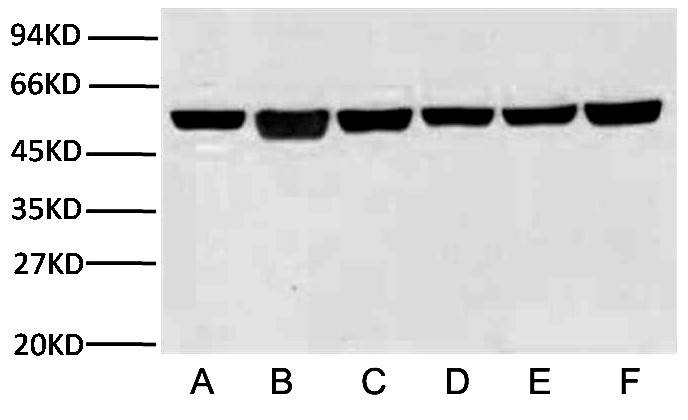| Product name | Universal Loading Control Antibody Cocktail |
| Applications notes | Universal Loading Control Antibody Cocktail provides a comprehensive and detailed method to quickly and conveniently detect the content of load control proteins in a variety of samples. |
| Kit components | • Anti-β-Actin Mouse Monoclonal Antibody (1C7)-60 μL*1 Tube • Anti-GAPDH Mouse Monoclonal Antibody (2B5)-60 μL*1 Tube • Anti-β-Tubulin Mouse Monoclonal Antibody (3G6)-60 μL*1 Tube • WB Positive Control-100 μL*1 Tube • SuperKine™ Enhanced Antibody Diluention Buffer-50 mL*2 Bottle |
| Features & Benefits | The universal internal reference antibody set is based on the innovation and optimization of the classic WB combination kit, which increases the storage time of the diluted antibody and can be used repeatedly. |
| Usage notes | • Do not mix components from different Lot and manufacturers; Otherwise, the result may be abnormal. • To obtain the best experimental results, you need to optimize all of your experimental elements, including sample number, antibody concentration, membrane and sealant use. • Please select appropriate and stable reference antibodies according to the sample and target protein.As in adipose tissue, beta-tubulin may be unstable. • Please follow the detailed instructions of each component. |
| Storage instructions | Store according to the recommended storage conditions of each component, stable for 12 months from date of shipment. |
| Shipping | Gel pack with blue ice. |
| Precautions | The product listed herein is for research use only and is not intended for use in human or clinical diagnosis. Suggested applications of our products are not recommendations to use our products in violation of any patent or as a license. We cannot be responsible for patent infringements or other violations that may occur with the use of this product. |
| Background | The Universal Internal Reference Antibody Cocktail is a set containing the antibodies β-actin, GAPDH and β-tubulin commonly used in immunoassay (WB, IHC-P, IF) as well as the antibody diluent. There are many kinds of internal reference antibodies. Therefore, the following three principles should be followed in choosing an appropriate internal reference antibody: 1.Considering the sample species, for mammalian tissues and cells, the commonly used reference proteins are β-actin, Tubulin, GAPDH, Lamin B1, PCNA, Na+/K+-ATPase, etc.For Plant samples, Plant Actin and RuBisCo are commonly used.Consider the molecular weight of the target protein. 2. The selected reference protein should have a different molecular weight from the target protein (>5 kDa) to distinguish the target protein bands. For high molecular weight proteins (over 100 kDa), we recommend that our clients use Vinculin as an internal reference; 2. Considering the expression and localization of target protein, select the corresponding internal reference, such as whole cell, nucleus, mitochondria, cell membrane and so on. |

Fig.1. WB experiment of β-Actin expression, the samples are Rat brain (lane 1), HeLa cell lysate (lane 2), Mouse brain (lane 3) each 10 ug, the primary antibody is β-Actin mouse monoclonal antibody ( 1C7) (A01010, 1:5000), the secondary antibody is goat anti-mouse IgG (A21010, 1: 10000).

Fig.2. WB experiment of GAPDH, the samples are Hela (lane 1), rat brain (lane 2), Mouse brain (lane 5) each 10 ug, the primary antibody is GAPDH mouse monoclonal antibody (2B5) (A01020, 1 : 10000), the secondary antibody is goat anti-mouse IgG (A21010, 1: 10000).

Fig.3. WB experiment of β-Tubulin, the samples are Rat brain (lane 1), A549 cell (lane 2), Mouse brain (lane 3) each 10 ug, the primary antibody is β-Tubulin mouse monoclonal antibody (2B5) (A01030, 1:10000), the secondary antibody is goat anti-mouse IgG (A21010, 1:10000).
Yes, the kit components can be applied to their respective experiments. If you need to communicate about individual products, please refer to the following link: ABL1010β-Anti-β-Actin Mouse Monoclonal Antibody (1C7), ABL1020Anti-GAPDH Mouse Monoclonal Antibody (2B5), ABL1030Anti-β-Tubulin Mouse Monoclonal Antibody (3G6), BMU103-ENSuperKine™ Enhanced Antibody Dilution Buffer.
Positive control lysates are used to show that the experiment is valid and correct, demonstrating that the target protein is not expressed in the sample. When setting up a new experiment, we strongly recommend the use of positive control lysates, which will enhance the reliability of the experiment.
Classical GAPDH, β -actin, and β -tubulin, which have been cited in hundreds of literatures, are the three most commonly used internal reference antibodies, which can be used for human, mouse, rat and other common species samples, and are widely used for internal reference of different sample types and molecular weight sizes.
Author:Ma, Qing, et al. Publication name:Cell Death & Disease IF:9
You must be logged in to post a review.
Reviews
There are no reviews yet.